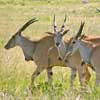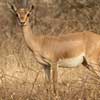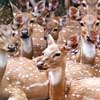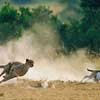Narayan Sarovar Sanctuary

Like the Wild Ass Sanctuary, Narayan Sarovar is home to a wide array of wildlife, including many species (15 of which are considered threatened) of mammals, reptiles, and birds. The principle species here is the chinkara, an Indian gazelle. In this harsh landscape, only animals well-adapted to the desert climate can thrive, with extreme heat, high winds, and frequent storms. For this reason, many species can be seen here that are not easy to find elsewhere.
Most of Narayan Sarovar is desert thorn forest and scrub forest, with some seasonal wetlands and dry savannah-type vegetation as well. Gorad and babul are the prevailing plant species; gorad in the east and babul in the west. Also found among the 252 species of flowering plants in the sanctuary are hermo, ber, pilu, thor, gugal, salai, ingorio, kerdo, carissa, and the invasive “gando baawal” (prosopsis juliflora), though less so than in other nearby areas.
The endangered chinkara is the only gazelle in the world with horns on both males and females. Of the roughly 7000 chinkaras known to exist, 80% of them live in Kutch, and since their primary habitat is the scrub and thorn forests so common here, Narayan Sarovar Sanctuary is crucial to their well-being. The sanctuary also houses many other mammals, from wildcats like the caracal (African or Persian Lynx) to desert foxes and the endangered Indian wolf, from spotted deer to wild boar. The ratel, or honey badger, renowned for its snake-killing ability and fierce self-defense against leopards, lions, poisonous snakes, and swarms of bees, earning it the title of "most fearless animal" in the Guinness Book of World Records, also lives here.
Birds abound in the sanctuary, with no less than 184 distinct species to be found here. All three species of bustards (the Great Indian Bustard, the Houbara Bustard, and the Lesser Florican) live here, as well as the Black Partridge, 19 different birds of prey, and many species of waterfowl. No bird lover will leave here displeased.
For information, contact: Assistant Conservator of Forests Narayan Sarovar Wildlife Sanctuary Kutch West Division, College Road, Bhuj, Gujarat Ph. 02832 230766
 Location
Location
 How to Reach Here
How to Reach Here
From Bhuj, 125 km away, buses go to Narayan Sarovar twice a day (morning and evening). However, that is the only public transportation available. Koteshwar Temple is a mere 2 km from Narayan Sarovar, on the coast, but visitors to Lakhpat (28 km further) or Narayan Sarovar Wildlife Sanctuary (15 km) will need a private vehicle; this can only be hired in Bhuj. Prices for hired cars range from Rs. 5.50/- per km to Rs. 10/- per km depending on the type of vehicle and whether or not it has AC.
Unless you only want to visit the Narayan Sarovar lake and temples, hiring a car in Bhuj is recommended. Accomodation and food are available in Narayan Sarovar, but not in any of the other three sites (except the gurudwara in Lakhpat.) Visitors to the wildlife sanctuary should bring their own food and water.




